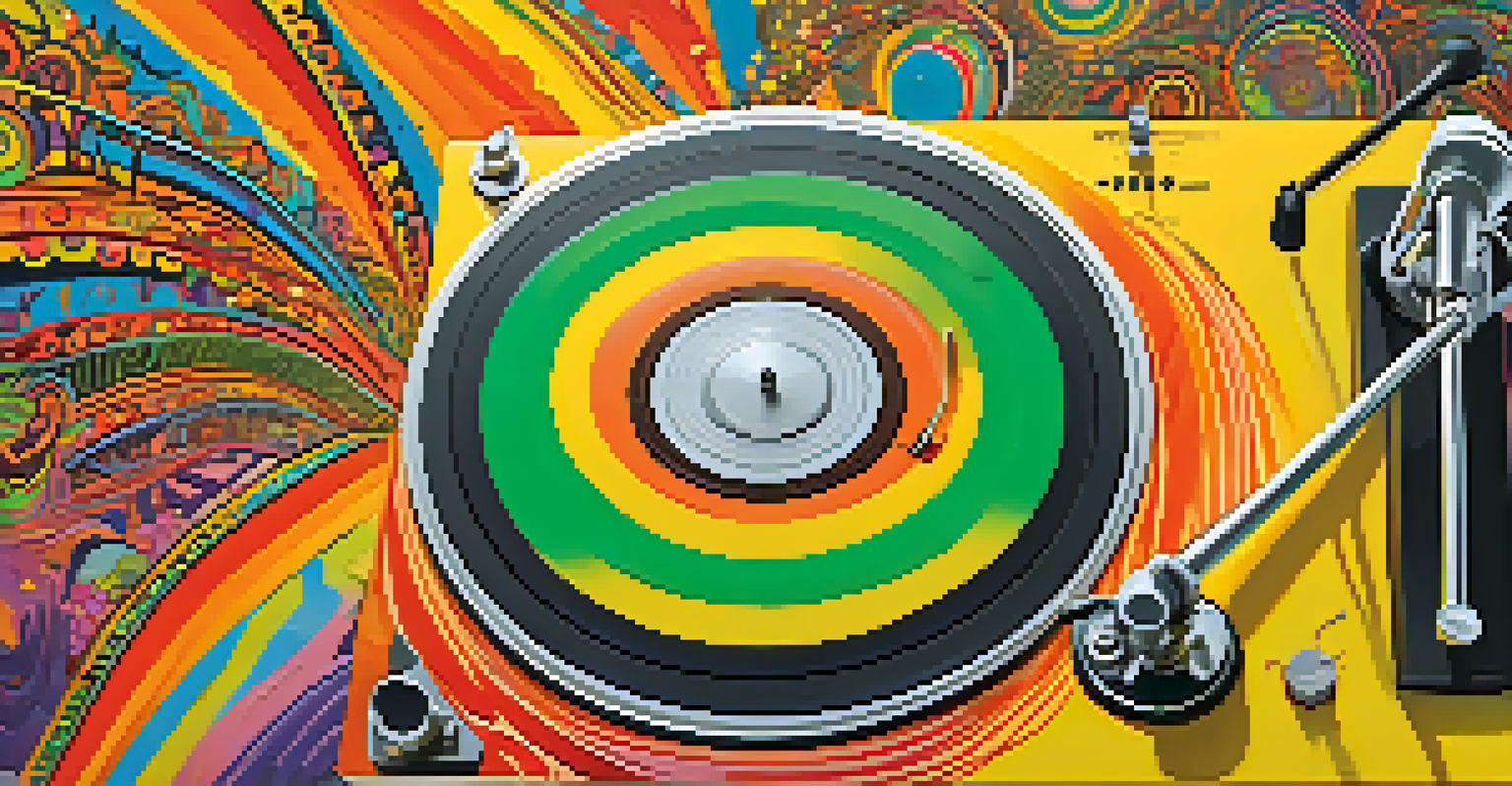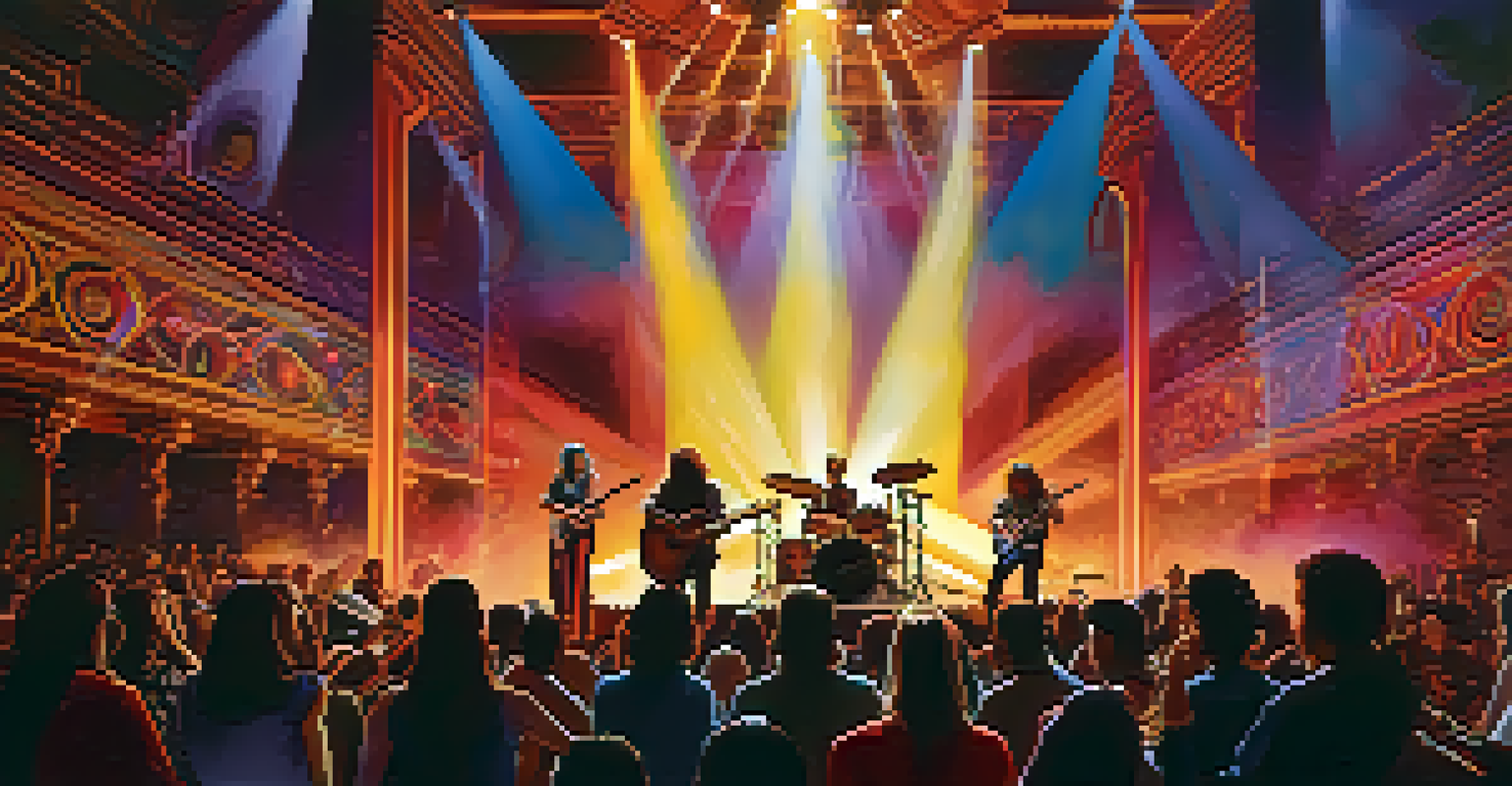Sonic Journeys: Hallucinogens in Progressive Rock Bands

The Roots of Progressive Rock: A Sonic Experimentation
Progressive rock emerged in the late 1960s as a genre that pushed musical boundaries. Bands like Pink Floyd and Yes were not just creating music; they were crafting experiences that invited listeners to embark on a journey. This experimentation often included complex time signatures, elaborate compositions, and a blend of various musical styles.
Music can change the world because it can change people.
The genre's roots can be traced back to the desire for artistic expression beyond the traditional pop formats of the time. Musicians sought to create immersive soundscapes that could resonate on a deeper level, often mirroring the psychedelic experiences of the era. This quest for innovation set the stage for the intersection of music and consciousness expansion.
As progressive rock gained momentum, it became a platform for exploring themes that went beyond everyday life. Lyrics often delved into philosophical and existential questions, reflecting the era's cultural shifts. This thematic depth made the music not just something to listen to, but something to experience.
Hallucinogens: A Catalyst for Creativity
Hallucinogens, particularly LSD, played a significant role in shaping the creative processes of many progressive rock musicians. Artists often sought altered states of consciousness to inspire new ideas and push the limits of their music. The influence of these substances can be heard in the expansive soundscapes and surreal lyrics that characterize the genre.

For many musicians, the experience of taking hallucinogens was not just about escapism; it was a way to tap into deeper layers of creativity. This practice often led to collaborations that produced groundbreaking albums, as artists shared their experiences and insights with one another. The communal aspect of these experiences fostered a unique musical synergy that defined the genre.
Progressive Rock's Sonic Innovation
Emerging in the late 1960s, progressive rock pushed musical boundaries through complex compositions and immersive experiences.
However, the relationship between hallucinogens and music creation is complex. While they provided a source of inspiration, the effects could also lead to unpredictable outcomes in the creative process. This duality contributed to the rich tapestry of sounds and themes found in progressive rock.
Iconic Albums: Soundscapes Shaped by Psychedelia
Many iconic progressive rock albums reflect the influence of hallucinogens, with 'The Dark Side of the Moon' by Pink Floyd being a prime example. The album's exploration of mental health and existential themes resonates with listeners, mirroring the introspective nature of a psychedelic experience. Each track flows seamlessly into the next, creating a cohesive auditory journey.
The most important thing in music is what is not said.
Another notable album is 'Close to the Edge' by Yes, which showcases intricate compositions that challenge conventional song structures. The band's use of complex harmonies and shifting rhythms creates a sense of movement, akin to the disorienting effects of hallucinogens. This album exemplifies how progressive rock artists translated their altered perceptions into musical form.
These works exemplify how hallucinogenic experiences can lead to profound artistic expression. The fusion of intricate musicianship and thought-provoking lyrics invites listeners to explore their own consciousness, making these albums timeless pieces in the progressive rock canon.
Lyrics: A Journey Through Altered Consciousness
The lyrics of many progressive rock songs often reflect the themes of exploration and self-discovery, heavily influenced by hallucinogens. Bands like King Crimson and Genesis used vivid imagery and abstract concepts to convey their messages. These lyrical choices invite listeners to interpret the songs through their own experiences, creating a personal connection with the music.
For instance, King Crimson's '21st Century Schizoid Man' discusses themes of confusion and disillusionment, resonating with the chaotic nature of a psychedelic trip. The use of surreal language transforms the song into a vivid narrative that can be felt rather than just understood. This approach to songwriting allows for a unique interplay between the listener's mind and the artist's vision.
Hallucinogens Shaping Creativity
The use of hallucinogens like LSD significantly influenced progressive rock musicians, inspiring innovative soundscapes and collaborative efforts.
As listeners engage with these lyrics, they often find themselves on a journey through their own thoughts and emotions. This experience mirrors the way hallucinogens can provoke introspection and revelation, further blurring the lines between music and consciousness.
Visual Art and Stage Performances: Enhancing the Experience
The influence of hallucinogens in progressive rock extended beyond just the music; it also permeated visual art and stage performances. Bands often collaborated with visual artists to create album covers and live shows that complemented their sonic explorations. This synergy between sound and visual expression enhanced the overall experience for audiences.
For example, the iconic cover of Pink Floyd's 'The Dark Side of the Moon' features a prism that symbolizes the spectrum of light, representing the band's exploration of consciousness. Such imagery invites listeners to engage with the music on multiple sensory levels, creating a more immersive experience. The fusion of art and music became a hallmark of the progressive rock movement.
Live performances often included elaborate light shows and projections that further amplified the psychedelic experience. These concerts became communal events where audiences could transcend reality, united by the music and visual spectacle. The combination of sound, sight, and altered consciousness created a unique atmosphere that defined the essence of progressive rock.
Cultural Impact: Progressive Rock and the Psychedelic Movement
The cultural impact of progressive rock is deeply intertwined with the psychedelic movement of the 1960s and 70s. As both movements sought to challenge societal norms, they became symbols of counterculture. Progressive rock provided a soundtrack for a generation exploring new ideas about consciousness, art, and existence.
This connection can be seen in the way music festivals and concerts embraced the ethos of peace and love, often incorporating elements of the psychedelic experience. Bands became ambassadors of this movement, using their platforms to promote messages of unity and exploration. The influence of hallucinogens was not just limited to individual creativity; it became a collective experience that shaped an entire generation.
Cultural Legacy of Progressive Rock
Progressive rock remains intertwined with the psychedelic movement, continuing to inspire new artists and reflect ongoing explorations of consciousness.
As the years have passed, the legacy of progressive rock continues to inspire new artists and movements. The genre's willingness to explore complex themes and sounds resonates with contemporary musicians seeking to push boundaries. The interplay between hallucinogens and progressive rock remains a fascinating topic, reflecting our ongoing quest for artistic expression and understanding.
The Enduring Legacy: Progressive Rock Today
Today, the influence of hallucinogens on progressive rock can still be felt, as new artists draw inspiration from the genre's rich history. Bands like Tame Impala and The Mars Volta incorporate elements of psychedelic rock into their sound, continuing the tradition of sonic exploration. This modern resurgence highlights the timeless nature of the themes and sounds established by earlier progressive rock pioneers.
Moreover, the ongoing interest in hallucinogenic experiences in both art and music reflects a broader cultural fascination with consciousness. As science continues to explore the potential benefits of psychedelics, the connection between these substances and creative expression remains relevant. Today's artists often seek to recreate the transcendent experiences that defined the classic progressive rock era.

Ultimately, the legacy of progressive rock and its relationship with hallucinogens serves as a reminder of the power of music to transcend boundaries. It invites us to explore our own consciousness and encourages a deeper understanding of both art and life, making it a vibrant and enduring part of musical history.